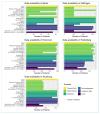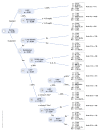Structured, Harmonized, and Interoperable Integration of Clinical Routine Data to Compute Heart Failure Risk Scores
- PMID: 35629415
- PMCID: PMC9147139
- DOI: 10.3390/life12050749
Structured, Harmonized, and Interoperable Integration of Clinical Routine Data to Compute Heart Failure Risk Scores
Abstract
Risk prediction in patients with heart failure (HF) is essential to improve the tailoring of preventive, diagnostic, and therapeutic strategies for the individual patient, and effectively use health care resources. Risk scores derived from controlled clinical studies can be used to calculate the risk of mortality and HF hospitalizations. However, these scores are poorly implemented into routine care, predominantly because their calculation requires considerable efforts in practice and necessary data often are not available in an interoperable format. In this work, we demonstrate the feasibility of a multi-site solution to derive and calculate two exemplary HF scores from clinical routine data (MAGGIC score with six continuous and eight categorical variables; Barcelona Bio-HF score with five continuous and six categorical variables). Within HiGHmed, a German Medical Informatics Initiative consortium, we implemented an interoperable solution, collecting a harmonized HF-phenotypic core data set (CDS) within the openEHR framework. Our approach minimizes the need for manual data entry by automatically retrieving data from primary systems. We show, across five participating medical centers, that the implemented structures to execute dedicated data queries, followed by harmonized data processing and score calculation, work well in practice. In summary, we demonstrated the feasibility of clinical routine data usage across multiple partner sites to compute HF risk scores. This solution can be extended to a large spectrum of applications in clinical care.
Keywords: HiGHmed; clinical routine data; heart failure; medical data integration center; medical informatics initiative; openEHR; risk prediction scores; semantic interoperability.
Conflict of interest statement
The authors declare no conflict of interest.
Figures




References
-
- Seferović P.M., Vardas P., Jankowska E.A., Maggioni A.P., Timmis A., Milinković I., Polovina M., Gale C.P., Lund L.H., Lopatin Y., et al. The Heart Failure Association Atlas: Heart Failure Epidemiology and Management Statistics 2019. Eur. J. Heart Fail. 2021;23:906–914. doi: 10.1002/ejhf.2143. - DOI - PubMed
-
- McDonagh T.A., Metra M., Adamo M., Gardner R.S., Baumbach A., Böhm M., Burri H., Butler J., Čelutkienė J., Chioncel O., et al. 2021 ESC Guidelines for the Diagnosis and Treatment of Acute and Chronic Heart Failure: Developed by the Task Force for the Diagnosis and Treatment of Acute and Chronic Heart Failure of the European Society of Cardiology (ESC). With the Special Contribution of the Heart Failure Association (HFA) of the ESC. Eur. J. Heart Fail. 2022;24:4–131. doi: 10.1002/ejhf.2333. - DOI - PubMed
-
- Lloyd-Jones D.M., Braun L.T., Ndumele C.E., Smith S.C., Sperling L.S., Virani S.S., Blumenthal R.S. Use of Risk Assessment Tools to Guide Decision-Making in the Primary Prevention of Atherosclerotic Cardiovascular Disease: A Special Report From the American Heart Association and American College of Cardiology. Circulation. 2019;139:e1162–e1177. doi: 10.1161/CIR.0000000000000638. - DOI - PubMed
Grants and funding
LinkOut - more resources
Full Text Sources
Research Materials
Miscellaneous

